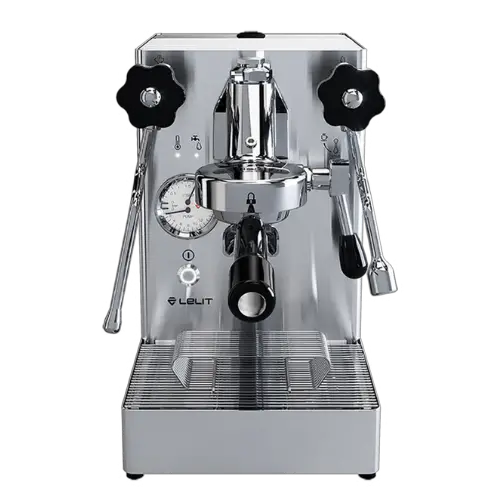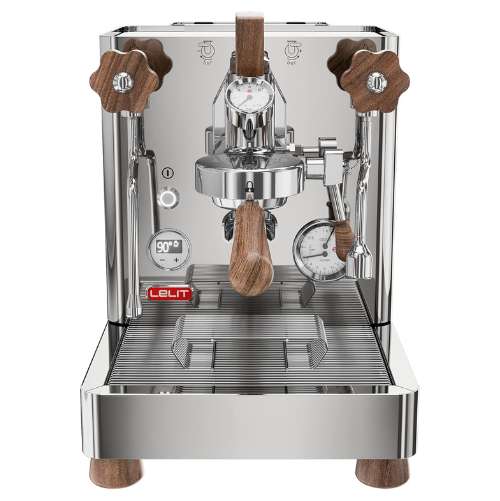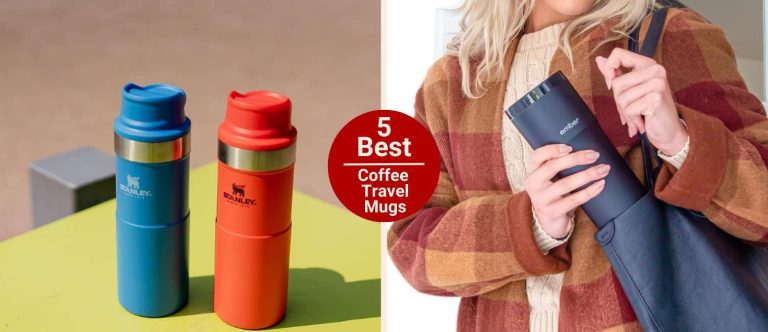5 Best Italian Espresso Machines in 2025
Last updated on May 26th, 2025 at 02:32 pm
Ever wonder why espresso just hits different in Italy?
I’ve always been drawn to the Italian espresso culture. The slow mornings, the tiny cups, the smell of freshly ground beans floating out of cafés on cobblestone streets.
Over the years, I’ve tried machines from Germany, the U.S., and even a few hyped-up newcomers. Some were good… really good. But in my opinion, nothing quite compares to the craftsmanship, flavor, and soul you get from an Italian machine.
So if you’re chasing that same rich, crema-topped magic at home, this guide’s for you.
I’ve rounded up the best Italian espresso machines—tested, compared, and broken down in a way that’ll help you pick the one that fits you. Whether you’re a beginner or full-on espresso nerd, you’ll find your match right here.
Top 5 Italian Espresso Machines
I’ve tested a bunch of machines over the years, but these five stood out for their build, consistency, and that unmistakable café-level experience at home. So, let’s break it down.


Best for Espresso lovers short on space
Lelit Mara X



Pro Features with Stylish Italian Design
Rocket Espresso R58 Cinquantotto



Ultimate Control with Flow Profiling
Lelit Bianca V3



Reliable Dual Boiler for Daily Use
Rancilio Silvia Pro X



Affordable Entry to Italian Espresso
Gaggia Classic Evo Pro

Best for Espresso lovers short on space
Rating:


1 – Lelit Mara X
The Lelit Mara X may look modest, but it delivers performance that rivals machines well above its price range—especially for a heat exchanger.
Once I dialed in my grind and got the temperature setting I liked (I usually leave it on “Hot”), the shots started coming out sweet, balanced, and super consistent.
Unlike some HX machines that need a cooling flush whenever you want to pull a shot, the Mara X handles temp stability like a champ. That’s because of its thermosiphon loop and double PID-controlled heat probes.

I didn’t need to baby it between shots, which made my mornings smoother.
The steam wand also surprised me. It’s powerful enough for silky microfoam and fast enough to get two cappuccinos going before the first one’s cold. Just flip the toggle for Xmode Steam if you’re doing a milk-heavy run.
Now, it’s not a dual boiler. So if you’re steaming and brewing back-to-back for a party, you might want something beefier.
But for daily espresso lovers (especially those who care about taste and aesthetics), the Mara X delivers café-quality performance in a home-friendly frame.
Click here to check Lelit Mara X price
Pro Features with Stylish Italian Design
Rating:


2 – Rocket Espresso R58 Cinquantotto
The Rocket R58 Cinquantotto is one of those machines that instantly makes your kitchen feel like a tiny Italian café. It’s sleek, shiny, and serious about espresso.
This isn’t just some pretty countertop appliance. It’s got the kind of power and precision you usually only find in commercial setups. The dual boiler setup? Makes a huge difference.
I used to have to choose between steaming milk or pulling a shot. With this thing, I’m making cappuccinos back-to-back without breaking a sweat, and the brew temp stays rock solid the whole time.
The rotary pump is another standout. It’s so quiet, I barely notice it’s on. Plus, it gives you the option to plumb the machine in or use the built-in water tank, which is great if you like flexibility.

And the external PID controller lets you fine-tune temperatures, schedule wake-ups, and control both boilers separately.
What surprised me was how refined the shots feel. With some trial and error, I was pulling these syrupy, crema-rich espressos that honestly rival anything I’ve had at specialty cafés.
There’s a learning curve, no doubt. However, if you’re the type who enjoys dialing things in and geeking out on pressure and temperature, this machine rewards you big time.
Plus, it has a solid build. I recommend this more for intermediate to advanced users.
Click here to check Rocket Espresso price
Ultimate Control with Flow Profiling
Rating:


3 – Lelit Bianca V3
If you’re the type who likes to tweak, test, and chase that perfect shot, this machine gives you more control than pretty much anything else.
The first thing you’ll notice is the flow control paddle on top of the group head. I’ll be honest, it took me a minute to figure out what to do with it.
But once I started adjusting pressure mid-shot, slowing down the flow, stretching pre-infusion, and even backing off near the end. Suddenly I was unlocking flavor notes I didn’t even know were in the beans.

The dual boiler setup means you can brew and steam simultaneously. Steam pressure? Strong, dry, and ready to whip milk into silky microfoam without a struggle.
Plus, it’s got a rotary pump, so you can plumb it in if you want to go full pro or just use the tank. Your call.
I also love the walnut wood accents. It sounds minor, but those wooden knobs and the paddle just give it this warm, handcrafted vibe that makes the machine feel more personal.
Now, it’s not exactly beginner-friendly. You should expect a learning curve, especially if you’re playing with flow control. But if you’re willing to experiment and mess up a few shots (okay, a lot at first), the Bianca rewards you with absolute dialing-in power. And honestly, that’s half the fun.
Click here to check Lelit Bianca V3 price
Reliable Dual Boiler for Daily Use
Rating:


4 – Rancilio Silvia Pro X
The Rancilio Silvia Pro X is built like a tank, no frills, all function and I mean that in the best way. This machine doesn’t mess around with flashy gimmicks.
Instead, it focuses on delivering solid, consistent espresso with just enough flexibility to make it worth the learning curve.
This machine comes (like others mentioned here) with a dual boiler system. So, you can brew and steam at the same time with no drop in performance.
The PID temperature control was dead accurate. I played around with different roast levels, and being able to tweak the brew temp by a single degree helped dial in the sweet spot for each one.
There’s also pre-infusion, which gently soaks the puck before pressure ramps up. You’ll notice it most when using lighter or more finicky grinds. Your extractions just come out more balanced.

I also like the steam wand. Commercial-style. Took me a few test runs to stop overshooting the milk temp. However, once I nailed the technique, the microfoam was buttery smooth.
Now the drip tray is small and far from perfect, and the design is rather ugly. But it’s stainless steel, solid and built to last.
But it’s stainless steel, solid, and built to last. You can feel it’s made with performance in mind, not just looks.
If you’re testing machines for reliability and consistency, especially in that under-$2k range, the Silvia Pro X checks a lot of boxes.
Click here to check Rancilio Silvia Pro X price
Affordable Entry to Italian Espresso
Rating:


5 – Gaggia Classic Evo Pro
The Gaggia Classic Evo Pro has been around for decades, and the newest version brings a few solid upgrades without messing with the stuff people love.
After testing it, I get why it’s so popular. Especially with people who are just getting serious about espresso at home.
This machine is fully manual, which means you’re doing all the work. For instance, timing your shots, managing your dose, and dialing in your grind.
It’s not plug-and-play, but that’s what makes it fun if you’re into learning the craft. Once I got it paired with a decent grinder and started experimenting, I was pulling some surprisingly good shots.

Furthermore, it’s got a commercial-style 58mm portafilter and a new OPV (over-pressure valve), which helps manage brew pressure more like a prosumer machine.
The steam wand is also a big improvement over older versions. It’s powerful enough to make real microfoam, though it does take a little practice to avoid overheating your milk.
Now, it’s still a single boiler machine. So you can’t brew and steam at the same time. I had to wait around 30 seconds to a minute to switch modes, which isn’t a big deal unless you’re trying to whip out drinks fast.
In terms of design, it’s simple and solid. All stainless steel, old-school rocker switches. I’d say it feels like something built to last a long time, not just look pretty on your counter. And yeah, it’s pretty budget-friendly compared to other Italian espresso machines, which makes it a go-to starter option.
Click here to check Gaggia Classic Evo Pro price
What Makes Italian Espresso Machines So Special?
There’s just something about Italian espresso machines that hits differently. You pull a shot and immediately feel the weight of decades of espresso culture behind it.
These machines aren’t just built to work, rather they’re built with care to make sure your coffee tastes good.
For instance, brands like La Marzocco, Rancilio, and Lelit. These companies have been doing this for decades. They know how to make machines that don’t just look nice on your counter. But actually deliver consistent, café-quality espresso over and over.

Premium Materials and Craftsmanship That Lasts
What I noticed with every Italian machine I tested? They’re built to last. Most of them use stainless steel, brass, and rock-solid internal parts. Nothing cheap or plasticky. They feel like machines you’ll still be using ten years from now.
Some even add beautiful wood accents or polished finishes that give off serious Italian design vibes.
Features That Let You Dial It In
A lot of these machines come with dual boilers, heat exchangers, and E61 group heads, which help keep your temps stable and your workflow smooth.
You’ll also find PID controllers for fine-tuning your brew temp, and sometimes pressure profiling paddles if you really want to nerd out.
As a result, you have more control, better consistency, and shots that reflect the quality of your beans.
Built to Be With You for the Long Haul
Honestly, most of these machines feel like something you keep for life. With basic maintenance, they’ll run for decades. And they’re the kind of machines that people upgrade with, not away from adding new parts, tweaking settings, and getting better and better with time.
How to Choose the Right Italian Espresso Machine for You?
Well, it all depends on what you need. What works for a beginner might frustrate a pro, and vice versa. So before you drop a bunch of cash, here’s how to figure out which one’s actually right for you.

Start with Your Experience Level
If you’re just getting into espresso, it’s easy to get overwhelmed. A machine like the Gaggia Classic Evo Pro is perfect for beginners because it’s manual but not overly complicated and you’ll learn a ton using it.
Now intermediate users might feel more at home with the Rancilio Silvia Pro X, which gives you more control and faster workflow thanks to the dual boiler setup.
If you’ve been pulling shots for a while and want café-level performance at home, something like the Lelit Bianca V3 or La Marzocco Linea Mini is built for you. These machines let you geek out with flow control, pressure profiling, and all the bells and whistles.
Understand Boiler Types (This Matters More Than You Think)
Boilers impact how fast and efficiently you can make drinks.
- Single boilers (like the Gaggia Classic) mean you’ll have to wait between brewing and steaming. Well, it’s doable but not ideal if you’re making back-to-back lattes.
- Dual boilers (like the Silvia Pro X or Linea Mini) let you brew and steam at the same time. No waiting.
- Heat exchanger machines sit somewhere in the middle and are a nice balance for many home baristas.
If you plan to make milk drinks regularly, dual boilers will save you time and frustration.
Check for PID Control, Steam Power & Pump Type
Temperature stability can make or break your espresso. The fact is PID controllers give you precision, which is essential for dialing in different roasts. For this, machines like the R58 Cinquantotto and Bianca V3 both have this covered.

As for steam, the power varies a lot. The Linea Mini and Silvia Pro X have serious steam output making it perfect for microfoam. However, beginners might prefer something gentler like the Gaggia, where you can take your time.
Also worth noting: rotary pumps (like in the Bianca or R58) are quieter and allow plumbing in, while vibration pumps (like in the Silvia Pro X) are a little louder but totally fine for home use.
Manual vs. Prosumer: How Much Control Do You Want?
Some machines are push-button simple, others hand you full control. If you like learning and adjusting things like pressure or flow rate, prosumer machines like the Bianca V3 or R58 are ideal.
If you’re newer or just want solid espresso without fiddling every time, the Silvia Pro X or Classic Evo Pro will get the job done with less of a learning curve.
Don’t Forget Space and Budget
Not all kitchens (or wallets) can handle a big prosumer machine. The Gaggia Classic Evo Pro is compact and way more affordable than something like the Linea Mini, which takes up more space and budget.
Notes: So investing in a quality machine can save you money long-termespecially if it means fewer café visits and better espresso at home. Just make sure you’ve got room for it and a solid grinder to match.
Last Thoughts
If you’ve tried any of these machines or have a favorite Italian model you swear by, I’d love to hear about it. And if you’re still trying to figure out which one fits your style, feel free to reach out. I’m happy to help.







